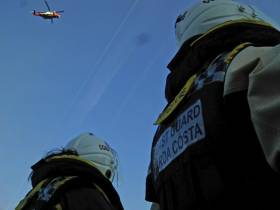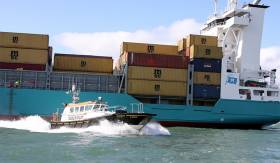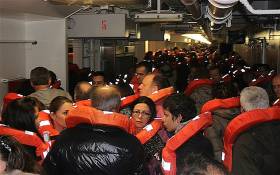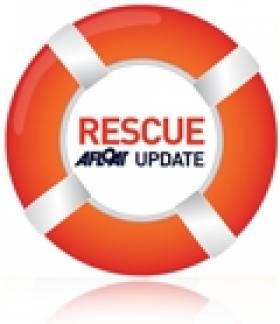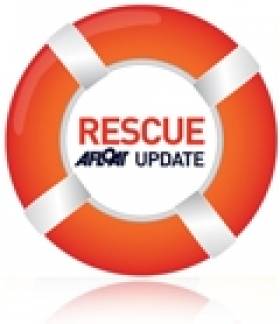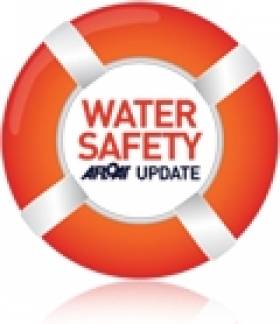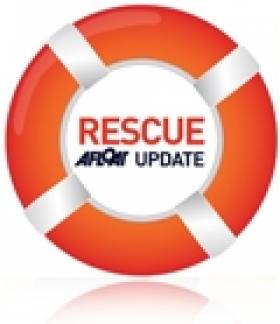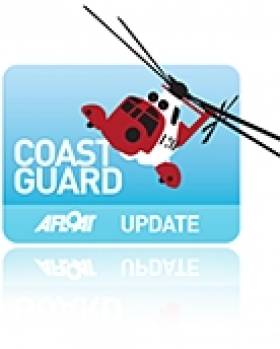Displaying items by tag: Safety
Stay Back, Stay High, Stay Dry Over Christmas Says Irish Coast Guard
#Coastguard - Stay Back, Stay High, Stay Dry is the message from the Irish Coast Guard to the public over the Christmas holiday period.
Many people will be engaging in outdoor activities along the coastline, be it on exposed coasts, cliffs, piers, harbour walls, beaches, promenades or other coastal areas.
And with the risk of stormy weather returning for Christmas Day tomorrow, after yesterday’s blustery conditions from Storm Barbara, the coastguard asks that anyone planning activities on or near the water to first check that it is safe to do so, and to be mindful of the risks and life threatening dangers that can arise without warning.
Christmas Day swims are a popular pursuit, and the coastguard is urging the public to only participate in organised swims where medical support and lifeguards are available.
Lone swimming should be avoided and all swimmers should be cognisant that time in the water should be kept to a minimum as even the most experienced of swimmers can easily succumb to cramp or cold water shock.
A general improvement in weather conditions is forecast from St Stephen’s Day — but spring tides that generate higher tides will peak in the latter part of the week and pose an additional risk.
The three Coast Guard Rescue Co-ordination Centres based in Malin, Valentia and Dublin, along with the coastguard helicopter service and volunteer units, will remain operational over the holiday period.
The Irish Coast Guard wishes to remind the public that if you see anybody in danger at sea, on the coast or on cliffs, call 112 and ask for the coastguard.
Anyone finding themselves involved in an emergency can use phone apps to help give their location to rescue personnel, as previously reported on Afloat.ie.
Maritime Priorities In Transport’s Statement Of Strategy 2016-2019
#Maritime - ‘Safe and sustainable’ marine transport and ‘delivery of emergency management services’ have been made a high level goal in the Department of Transport, Tourism and Sport’s Statement of Strategy 2016-2019, published this week.
Identifying Ireland’s maritime sector as “a critical gateway” for trade and tourism, the statement calls for “an efficient and effective competitive ports sector [that] can foster job creation” via trade, infrastructure developments and “opportunities in other areas such as offshore energy, cruise and marine leisure and recreation.”
Reduced ship emissions and safety at sea are also priorities within the Maritime Safety Strategy, which “includes a range of actions to be implemented or begun by 2019” such as flag state and port state regimes, and the IMO’s Convention on Standards of Training, Certification and Watchkeeping for Seafarers.
Key services in this strategy include the delivery of a 24/7 marine emergency response and management service by co-ordinating the response to SAR incidents and pollution threats at sea.
Progress on these goals will be monitored by various indicators, such as the transfer of regional ports to local authority control by the end of 2018, the imposition of a new ‘ports performance’ measurement system by the end of 2017, the development of a web portal for SeaSafe Ireland by the middle of next year, as well as a minimum 90% availability of Irish Coast Guard units ahead of “full interoperability” of marine rescue co-ordination by next winter.
The full Statement of Strategy 2016-2019 can be downloaded HERE.
What You Didn't Know About Cruise–Ship Safety
It may have to take another disaster of Titanic proportions before lifesaving provisions on board cruise ships are improved.
That might seem like a bit of hyperbole – an exaggerated statement or claim not meant to be taken literally, but it came from a maritime source which deserves respect – an international forum of professionals.
• Listen to the Podcast below.
NAUTILUS is the international trade union and professional organisation representing more than 22,000 maritime professionals in the UK, theNetherlands and Switzerland. Its International Professional and Technical Forum issued that warning after a meeting in Hull in England where facts that will surprise the public about cruise ship safety were revealed.
As cruise ships get bigger and bigger, with a 6,000 passenger capacity amongst the biggest, fears have been increasingly expressed about safety and evacuation procedures, which were heightened by the Costa Concordia disaster.
It is surprising to hear that every passenger is not guaranteed a seat in a lifeboat and that some passengers, because of their size, might not even fit in lifeboat seats. According to the NAUTILUS professionals, the SOLAS, safety of life at sea regulations, only require that there is lifeboat capacity for 37.5 per cent of passengers on each side of a cruise ship, providing that liferafts increase that capacity to 125 per cent, meaning apparently that not every passenger would be catered for in a lifeboat in an emergency.
And even if seats are available, the Forum was told that seats only allow for an average mass of 75 kilograms per person and a seat with of 16.9 inches which, the professional forum concluded, does not take into account increases in the average height and weight of passengers.
The general public will be surprised by these findings, the NAUTILUS professionals said. They have called for a lifeboat seat for every passenger onboard – and a guarantee that passengers will fit into them.
The professionals said that passengers may be surprised to learn that this is not already the case.
Yachtsman & Cat Make Leap to Safety
This US Coast Guard video shows the stricken sailor riding several waves before jumping head first over the railing of a rescue ship. The yachtsman's dramatic leap, with his cat, to safety from his disabled yacht was made some 400 miles south of Cold Bay, Alaska.
#safetyatsea – Last Thursday (April 16) the Department of Transport published its Maritime Safety Strategy, resulting from the "Sea Change" consultation last year. By chance this coincided exactly with our publication of the ICC's independent analysis of the Marine Casualty Investigation Board reports which form the background to the programme. Norman Kean has now reviewed the latest proposals.
The new Maritime Safety Strategy contains much sensible encouragement, and also 33 proposals for action by the Irish Maritime Administration, under five headings. These include:
• "Intensification of efforts to promote maritime safety awareness through a process of information and communication, and the promotion of more effective communication between key stakeholders"
• "An appropriate regulatory regime for the seaworthiness of vessels and craft and the competency of operators and/or crew"
• "Building on the current enforcement regime."
What does this mean for leisure sailors? Under the Information and Communication heading are some sensible proposals, such as widening the membership of the Marine Safety Working Group, organising an annual maritime safety conference to be open to the public, and addressing children and young people through the education system. This goes some way to recognizing the fact that the people most at risk are not connected to the established organization of sailing clubs and training systems. Lack of awareness is the biggest killer of all.
"Appropriate regulatory regime" translates into the intent to update the Code of Practice for Safe Operation of Recreational Craft, starting in 2016. It is to be hoped that this will be done in a proportionate and well-informed manner, and that the word "should" in respect of things like carriage of equipment does not too often morph into "must". Perish the thought that we might be required by law to submit our boats to annual Government inspection, that we should be compelled on pain of prosecution to report every single arrival and departure to Coast Guards or Harbourmasters, that we might be forced to transmit AIS signals all the time on pain of a fine. All those and many more have been suggested in submissions at the consultation stage of this process. This must not be the thin end of the wedge. Transmitting AIS is undoubtedly a good idea in busy waters, but the accident statistics don't support making it compulsory. We do not need, and we certainly do not want, a Big Brother regime, and the absence of any explicit proposals in that direction is to be welcomed.
Starting in 2017, jet skis and many small speedboats will have to be registered, as defined in the new Registration of Ships Bill, and it appears that the timeline for a new voluntary small craft register will start in 2018. This is far too late. The lack of such a facility for the next three years will leave many owners with no choice but to flag out to other EU states, to avoid facing voyage restrictions and having Irish yachts, at present abroad, put at risk of being impounded for lack of ship's papers.
But it begs the question, what does all that have to do with safety? Might the mention of registration here be a step in the direction of inspection - and ultimately taxation?
A new focus is proposed on more rigorous enforcement of existing legal requirements, with extension of on-the-spot fines for breaches of lifejacket laws quoted. That particular example is common sense and should be applauded by all responsible sailors. The great majority of recreational craft fatalities occur in small open boats and the majority of casualties are not wearing lifejackets when they should be. Conspicuous enforcement would get the attention of those most at risk. Last summer we came across a speedboat grossly overloaded with eleven people aboard; none of the five adults was wearing a lifejacket. If the skipper had been met on the pontoon by a couple of burly Guards who promptly relieved him of several hundred euro, the word might get round and the message might get through. But there must be no mission creep. I was once, at the helm, accosted by a Coast Guard crew who asked me, none too gently, where my lifejacket was, to which I replied that it was safely in its locker, that this vessel was 16 metres in length and perhaps they would care to read their own rules.
Under "Data and Evaluation" it is proposed to commission a baseline study of attitudes to maritime safety. The sailing clubs of Ireland need to be proactive in taking part in that. In respect of cruising sailors, the RNLI is currently doing exactly the same thing, and we must hope that the Maritime Administration takes the results of that study fully into account. Despite the rising trend in callouts to recreational craft, the RNLI continues to be firmly in favour of education over compulsion.
#maritimesafety – The Minister for Transport, Tourism and Sport, Paschal Donohoe, TD, today launched a new Maritime Safety Strategy 2015 – 2019, the theme of which is 'Make Time for Maritime Safety.'
The new Strategy was developed following a consultation with key stakeholders and the general public and includes an analysis of the factors contributing to maritime fatalities in Ireland.
A link to the Maritime Safety Strategy document is HERE.
"My Department's maritime safety remit covers safety on recreational craft, including surfboards, fishing vessels and cargo ships and it is these areas which are covered by the Strategy we are launching today. Although the average annual number of marine incident-related fatalities, at 11, is low, lives continue to be lost on the water, despite regulation, inspections and training. Perhaps not surprisingly, most incidents happen in the fishing and recreational sectors. What is striking, however, is the fact that 99% of maritime fatalities are male, with an average age of 44, and that fatalities in the maritime sector are potentially avoidable.
"There is broad agreement in the sector that to reduce fatalities, the focus needs to be on changing culture and personal behaviour rather than on more regulation. While this Strategy primarily identifies actions that the Department, through the Irish Maritime Administration (IMA) will take, the important roles of individuals, families, friends and sectoral organisations are also highlighted.
"Notwithstanding the efforts of my Department in terms of preventative action, enforcement and emergency response, these efforts cannot on their own improve maritime safety. It is up to each individual who takes to the water to take personal responsibility for their actions and to understand that failure to operate safely puts not just their own life at risk, but the lives of others on board and potentially the lives of emergency and rescue personnel.
"The genesis of this Strategy was the emergence of recurring causal factors in marine casualty investigation reports and recognition of the extent to which maritime fatalities and incidents could be avoided. Among the top 10 factors identified from analysis of the Marine Casualty Investigation Board (MCIB) reports are:
· The need for an enhanced maritime safety culture
· Unsuitable or inadequately maintained safety equipment on board, or lack thereof
· Lack of crew training
· Failure to plan journeys safely, including failure to take sea/weather conditions into account
· Non-wearing of personal flotation device (lifejacket/buoyancy aid)
· Vessel unseaworthy, unstable and/or overloaded
"The 33 actions outlined in the report are grouped under five over-arching strategic objectives; Information and Communication, Search and Rescue Operations, Standards, Enforcement, Data and Evaluation. They are centred on promoting personal responsibility for maritime safety, improving search and rescue, and implementing preventative measures, including a robust inspection and regulatory framework, and an enhanced enforcement regime. They are designed, in a holistic way, to tackle the factors contributing to maritime fatalities and to ultimately reduce in the number of lives lost in the maritime sector.
"This strategy sets out in a very straightforward way, what individuals, families, friends and communities can do to ensure safety when taking to the water. This includes proper planning, operating on a safety first basis, always telling somebody where you are going and when you expect to be back, wearing suitable clothing and always wearing lifejackets and buoyance aids. The Strategy concludes by outlining what my Department can and will do to support a better maritime safety culture. I urge everyone involved in the sector to pay close heed to the Strategy's contents so that together we can reduce, and eventually eliminate, needless fatalities at sea."
#watersafety - August is the most popular month for outdoor swimming, prompting Irish Water Safety's appeal to swim at Lifeguarded waterways and to stay close to shore and within your depth.
Ireland averages 135 drownings every year. Drownings happen quickly and silently yet people can stay safe by heeding the following advice:
Safe Swimming in August:
1. Swim at lifeguarded waterways - all listed at www.iws.ie.
2. Swim within your depth and stay within your depth.
3. Swim parallel and close to shore.
4. Swim with others in bathing areas that are traditionally recognised as safe.
5. Never use inflatable toys in open water or swim out after anything drifting.
6. Pay attention to signs on the beach and supervise children at all times.
7. Never swim in the dark, late at night or after consuming alcohol.
8. Avoid staying in the water too long.
9. In Marine Emergencies, call 112 and ask for the coastguard.
No matter what your aquatic activity, when you are on or near water always wear a correctly fitted lifejacket with a crotch strap.
Children are curious about water therefore it is critical that adults supervise children at all times.
Calls for Sea Change in Attitudes to Maritime Safety
#seasafety – Minister for Transport, Tourism & Sport Leo Varadkar has called for a sea change in attitudes to maritime safety, as he launched a new consultation process on maritime safety: Sea Change – Building a new Maritime Safety Culture. But even as the Minister was preparing for today's event Howth Cooast Guard was bringing to safety two children recovered from a small dinghy off North Co Dublin on Monday evening.
Minister Varadkar highlighted the 134 maritime fatalities which have occurred since 2002, almost half of which were as a result of leisure activities on recreational craft. As Afloat.ie reported earlier the Minister was speaking at the launch of the consultation process in the Department of Transport, Tourism & Sport which included stakeholders from shipping, fishing, leisure, passenger operators, maritime safety and many other sectors.
Minister Varadkar said: "We all need to take a fresh look at how we use the waters in and around our island, and build a culture of maritime safety in our communities. This requires a radical change of culture in our attitude to safety."
"The sea and any open water can be hostile and dangerous environments and demand total respect. By consulting with stakeholders and the general public, we want to reach a situation where there are no fatalities."
The results of the consultation process will feed into the first ever Maritime Safety Strategy for Ireland. This Strategy is being prepared by the Department of Transport, Tourism & Sport. This approach borrows from the very successful road safety strategies that have helped make Ireland's roads considerably safer over the last 15 years.
The goal is to reduce the number of deaths and injuries which occur every year on craft in our coastal and inland waters. This will be done by building a culture of safety in the maritime sector, for all types of craft, with a focus on maritime safety issues, and by posing key questions to shape the new Maritime Safety Strategy.
Sea Change looks at how to address the top ten factors contributing to loss of life at sea in Ireland:
Lack of an adequate maritime safety culture;
Unsuitable or inadequately maintained safety equipment on board, or lack thereof;
Lack of crew training;
Failure to plan journeys safely, including failure to take sea/weather conditions into account;
Non-wearing of personal flotation device (PFD);
Vessel unseaworthy, unstable and/or overloaded;
Inadequate enforcement of regulations;
Impairment due to fatigue or the influence of alcohol and/or drugs;
Inadequate crewing levels/solo operation;
Unsuitable clothing being worn on board.
Minister Varadkar said: "The number of tragedies around our coastline, and the effect of those events on families, has put the need for a new Maritime Safety Strategy into sharp focus. We have to learn from past tragedies, in memory of those who have lost their lives, and safeguard future generations. There is a lot of goodwill towards improving safety at sea, but we need to harness that goodwill."
"I urge all stakeholders, and the general public, to engage with this consultation process and to contribute their ideas to the Irish Maritime Administration in my Department as we strive to improve maritime safety together. My hope is that a wide range of responses will be received, and that positive ideas will emerge which will enable us to take further practical measures to save lives in the maritime sector, since any life lost is one too many."
The consultation period runs until 29th August 2014, and the new Strategy will be published later this year. The Strategy will be monitored closely during implementation and reviewed and updated within a five year period.
There have been a total of 134 fatalities in the Maritime Sector since 2002:
Leisure activities:
66 fatalities (49% of total)
Youngest fatality (15yrs)
Oldest fatality (71yrs)
Fishing Sector:
51 fatalities (38% of total)
Youngest fatality (21yrs)
Oldest fatality (70yrs)
Passenger Sector:
11 fatalities (8% of total)
Youngest fatality (14yrs)
Oldest fatality (73yrs)
Cargo Sector:
6 fatalities (5% of total)
Youngest fatality (20yrs)
Oldest fatality (55yrs)
The Irish Maritime Administration
The Irish Maritime Administration (IMA) was established in 2013 to integrate the planning and delivery of all the maritime services of the Department under a single national office. It is central to the Department's drive for more efficient and effective delivery of maritime services.
It comprises the Maritime Safety Policy Division, the Marine Survey Office, the Irish Coast Guard, the Maritime Transport Division and a new Maritime Services Division.
The IMA is developing the maritime transport sector by facilitating the achievement of international safety levels and by enhancing infrastructure needed to secure employment in the shipping, fishing and leisure sectors.
#coastguard – The Irish Coast Guard has today issued advice to members of the public in advance of the June Bank Holiday in relation to Water Safety, Cliff Walking and other Water sports and Coastal Activities.
Throughout the summer (as at other times of the year), Irish Coast Guard Units throughout the country will patrol our rivers, lakes, waterways and coastlines issuing safety advice and information to holidaymakers and tourists. Traditionally over the Bank Holiday weekend many people take to the water and enjoy outdoor active weekends, including cliff walking and this weekend the Irish Coast Guard begin their Summer Safety campaign.
Speaking ahead of the weekend Declan Geoghegan, Manager at the Irish Coast Guard, said "With the warmer weather and bank holiday weekend we are expecting more people to enjoy water and coastline activities but we would remind people to be safety conscious when engaged in such activities. Water sports are a popular and enjoyable pastime but we ask people to heed the advice and if you see someone in difficulty dial 112/999 and ask for the Coast Guard."
Last year the Coast Guard saw an increase in incidents and is urging everyone to heed the advice and enjoy the water and coastal activities in a safe manner over the bank holiday weekend and throughout the summer:
Swimming
Only swim at beaches and waterways that have lifeguards on duty and pay attention to the safety flags, avoid locks and weirs. Ask the Lifeguard for advice about safety and water conditions and adhere to their instructions.
Never go out on the water, including rivers and lakes, having consumed alcohol.
Be able to swim. Get the proper training to stay safe.
Never go out alone.
Familiarise yourself with the local area, be aware of your own capabilities.
Swim parallel to the shore and not in deep water.
Keep warm before and after swimming.
Have a means of alerting the emergency services.
Avoid using inflatable toys, such as lilos and rubber rings, on the water.
Cliff Walking
There is safety in numbers, so never be alone if possible. Let somebody know when and where you are going and what time you will be back. Stay well away from the cliff edge, both top and bottom. Don't attempt to rescue people or pets if they fall over the edge. If assistance is required dial 112/999 and ask for the Coast Guard.
Water Sports and Coastal Activities
Before going to sea check local weather conditions and tides in the area. Personal Flotation Devices include lifejackets and buoyancy aids. It is vital to wear a lifejacket or buoyancy aid if your activity takes you near the water. This doesn't just mean the sea – it includes lakes and rivers too. If you enjoy sports like jetskiing, windsurfing, water skiing and canoeing, wearing the appropriate Personal Floatation Device will give you added confidence when in the water. Also, in the event of an emergency, it will help you remain afloat while the Search and Rescue services locate you. Lifejackets are of no use unless they are worn. Ensure your craft is fit for purpose. Always advise someone as to where you are going and the time of your intended return. Do not overload the craft. If you are in difficulty or see someone in difficulty and requiring assistance dial 112/999 and ask for the Coast Guard.
For specific advice and information on any water and coastal activity, visit www.safetyonthewater.ie.
Also the Irish Coast Guard provide free waterproof wristbands for children to assist the emergency services in contacting a parent or guardian should it be required. These wristbands distributed last year as part of the "Give us a Hand" campaign can be attained at Coast Guard stations nationwide.
Enhanced Safety Training for Skippers and Crews of Fishing Vessels
#fishing – Marine Notice No. 16 of 2014
Notice to all Fishing Vessel Owners, Skippers, Fishermen and Seafarers
Enhanced Safety Training for Skippers and Crews of Fishing Vessels Less than 15m Length overall
This Marine Notice is published in accordance with Section 8.6 of the Code of Practice for the Design, Construction, Equipment and Operation of Small Fishing Vessels of less than 15m Length overall (Rev.2), regarding the updating of safety skills and knowledge.
The following training course providers are approved to provide the required training under the Code of Practice:
Course Provider Details:
BIM Marine Services Division,
P.O. Box No 12,
Crofton Road,
Dun Laoghaire,
Co. Dublin.
Email: [email protected]
Tel: +353 (0) 1 214 4100
B.I.M. National Fisheries College,
Greencastle,
Co. Donegal.
Email: [email protected]
Tel: +353 (07493) 81099/ 81068
B.I.M. Regional Fisheries Centre,
Castletownbere,
Co. Cork.
Email: [email protected]
Tel: + 353 (0) 27 70450 /71106
Irish Maritime Administration,
Department of Transport, Tourism and Sport,
Leeson Lane, Dublin 2, Ireland.
For any technical assistance in relation to this Marine Notice, please contact:
The Marine Survey Office, Leeson Lane, Dublin 2, tel: +353-(0)1-678 3400.
For general enquiries, please contact the Maritime Safety Policy Division, tel: +353-(0)1-678 3418.
Written enquiries concerning Marine Notices should be addressed to:
Maritime Safety Policy Division, Dept. of Transport, Tourism and Sport, Leeson Lane, Dublin 2, Ireland.
email: [email protected] or visit us at: www.dttas.ie
27/01/2014



























